Elevate your cold tea experience with these 10 flavorful herbs. Invigorating peppermint offers a cooling sensation, while zesty lemongrass adds a citrusy kick. Soothing chamomile and aromatic lavender promote relaxation, and tangy hibiscus provides a bold, berry-like taste. Citrusy lemon balm revitalizes, spicy ginger adds a fiery punch, and floral rose petals bring elegance. Sweet licorice root naturally sweetens, and earthy rosemary adds depth. Each herb not only enhances flavor but also offers unique health benefits, from aiding digestion to boosting immunity. Discover how these versatile herbs can transform your cold tea into an invigorating and beneficial experience.
Refreshing Peppermint
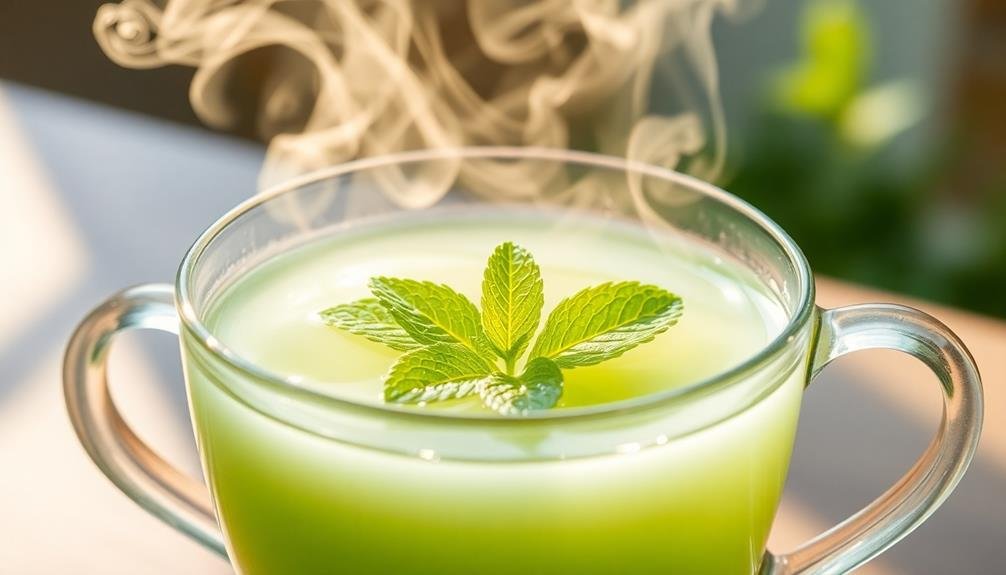
Cooling and invigorating, peppermint is a go-to herb for revitalizing cold tea. Its menthol content provides a rejuvenating sensation that's perfect for hot summer days. You'll find that peppermint's crisp flavor cuts through the heaviness of traditional iced teas, leaving you feeling revitalized and energized.
To incorporate peppermint into your cold tea, you have several options. You can steep dried peppermint leaves directly in cold water for 4-6 hours, or brew a hot peppermint tea and let it cool. For a more intense flavor, muddle fresh peppermint leaves before adding them to your tea. You'll notice that peppermint pairs well with green and black teas, adding a bright, minty note to their existing flavors.
Beyond its taste, peppermint offers potential health benefits. It's known to aid digestion, relieve headaches, and clear sinuses. When you're feeling sluggish, a glass of peppermint-infused cold tea can provide a natural, caffeine-free boost.
Experiment with different ratios of peppermint to tea to find your perfect balance. You can also combine it with other herbs like lemon balm or spearmint for a more complex flavor profile.
Zesty Lemongrass
While peppermint offers a cool and invigorating taste, lemongrass brings a zesty, citrusy flavor to cold tea. This tropical herb adds a bright, lemony note without the acidity of actual lemons.
You'll find that lemongrass tea is rejuvenating and uplifting, perfect for hot summer days or when you need an energy boost.
To prepare lemongrass cold tea, steep fresh or dried lemongrass stalks in hot water for about 10 minutes, then chill. You can also add lemongrass to your favorite black or green tea blend for an extra layer of flavor. It pairs well with ginger, mint, or honey for a more complex taste profile.
Lemongrass isn't just delicious; it's also packed with health benefits. It's known for its anti-inflammatory properties and may help reduce fever, relieve digestive issues, and even lower cholesterol levels.
You'll also benefit from its high antioxidant content, which can support your immune system and overall health.
When selecting lemongrass, look for firm stalks with a pale yellow-green color. If using fresh lemongrass, bruise the stalks before steeping to release more flavor.
For a stronger brew, you can increase the steeping time or use more lemongrass.
Soothing Chamomile
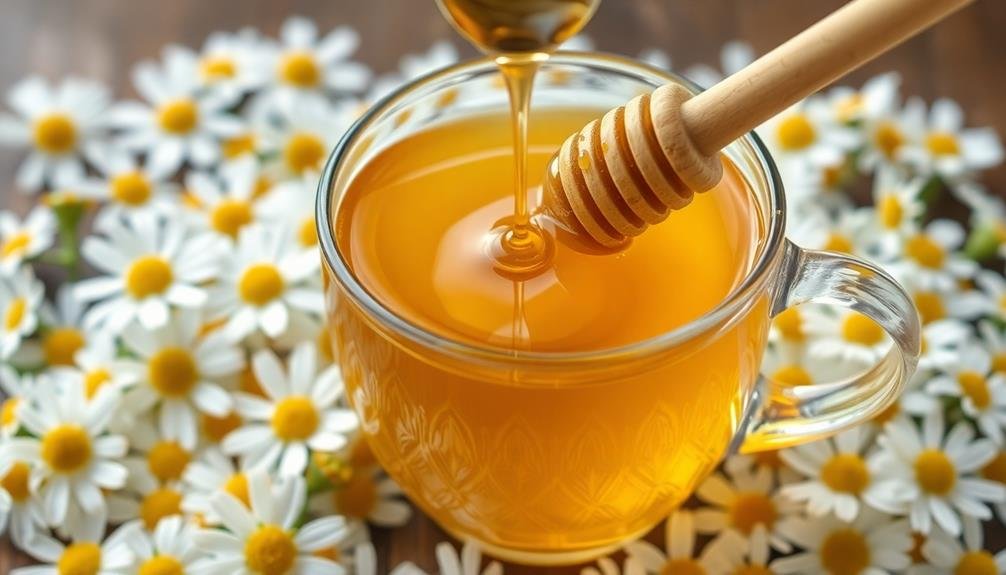
You'll find chamomile to be a powerhouse of tranquility in your cold tea arsenal.
Its calming properties can help melt away stress and tension, making it an ideal choice for unwinding after a long day.
In addition, chamomile's sleep-inducing effects may improve your quality of rest when consumed before bedtime.
Calming Properties
A warm cup of chamomile tea can be your gateway to tranquility. This gentle herb's calming properties stem from its active compounds, primarily apigenin, which binds to specific receptors in your brain. As you sip, you'll notice a subtle relaxation spreading through your body and mind.
Chamomile's soothing effects can help alleviate anxiety and reduce stress levels. It's particularly effective before bedtime, as it may improve sleep quality and help you fall asleep faster. If you're dealing with tension headaches or migraines, chamomile's anti-inflammatory properties might offer some relief.
Beyond its mental benefits, chamomile can also ease digestive discomfort. It may help reduce bloating, gas, and stomach cramps, making it an excellent choice after a heavy meal. For women, chamomile can provide relief from menstrual pain and mood swings.
To maximize chamomile's calming effects, steep your tea for 5-10 minutes in hot water. You can enhance its flavor and benefits by adding a touch of honey or a slice of lemon.
Stress-Relief Benefits
Chamomile's calming properties extend beyond relaxation, offering significant stress-relief benefits. When you brew chamomile tea and sip it cold, you're tapping into a natural remedy that can help reduce anxiety and promote a sense of well-being.
The flavonoids in chamomile interact with your brain receptors, potentially lowering stress hormones and easing tension.
You'll find that regularly drinking cold chamomile tea can improve your sleep quality, which is essential for managing stress. It may also help alleviate symptoms of mild depression and boost your mood.
The herb's anti-inflammatory properties can reduce physical manifestations of stress, such as headaches and digestive issues.
Sleep-Inducing Effects
Insomniacs and restless sleepers alike can find solace in chamomile's renowned sleep-inducing effects. This gentle herb contains apigenin, a compound that binds to specific receptors in your brain, promoting relaxation and drowsiness.
When you steep chamomile in cold tea, you're creating a revitalizing and calming beverage that can help ease you into a peaceful slumber.
To maximize chamomile's sleep-inducing potential, try drinking your cold chamomile tea about an hour before bedtime. This allows enough time for the herb's compounds to take effect. You can enhance its potency by combining chamomile with other sleep-friendly herbs like lavender or valerian root.
Keep in mind, consistency is key – make chamomile cold tea a regular part of your nighttime routine for best results.
While chamomile is generally safe, it's crucial to recognize that some people may experience allergic reactions, especially if they're sensitive to plants in the daisy family.
If you're pregnant, nursing, or taking medications, consult your healthcare provider before incorporating chamomile into your daily regimen.
Aromatic Lavender
With its delicate purple flowers and soothing fragrance, lavender is a popular choice for cold tea blends. You'll find that adding lavender to your cold tea not only enhances the flavor but also provides numerous health benefits. This aromatic herb is known for its calming properties, helping to reduce stress and anxiety.
When brewing lavender cold tea, you'll want to use dried lavender buds rather than fresh flowers. Steep about a teaspoon of buds per cup of cold water for 5-10 minutes. You can adjust the steeping time to suit your taste preferences. For a more intense flavor, try crushing the buds slightly before steeping.
Lavender pairs well with other herbs and flavors. You might combine it with chamomile for an extra relaxing blend, or mix it with lemon balm for a revitalizing citrusy twist. If you're feeling adventurous, try adding a touch of honey or a slice of lemon to your lavender cold tea.
Remember that a little lavender goes a long way. Start with small amounts and adjust to your liking. You'll soon discover the perfect balance of this aromatic herb in your cold tea creations.
Tangy Hibiscus
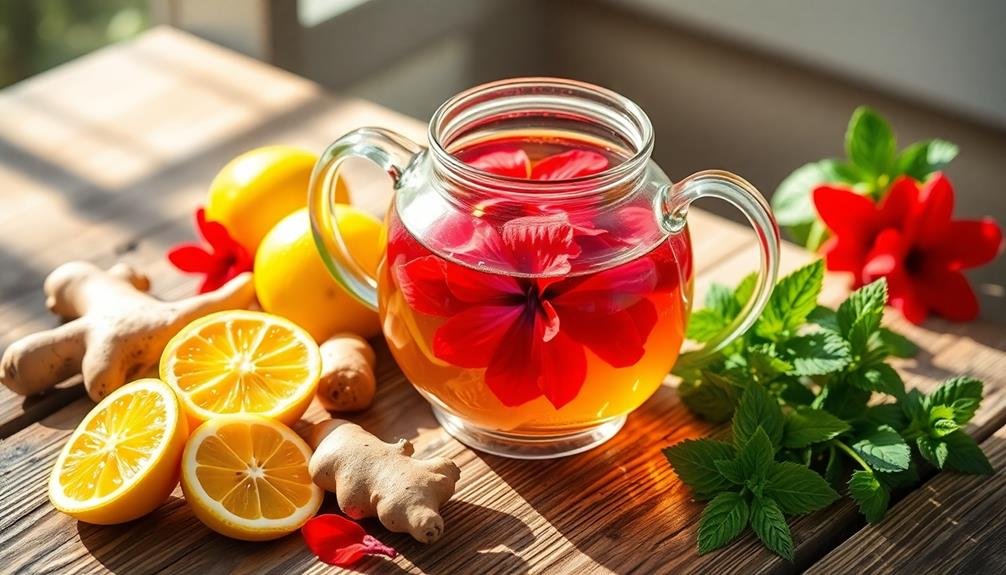
From the soothing tones of lavender, we now turn to the vibrant world of hibiscus. This striking crimson flower offers a tangy, tart flavor that's perfect for invigorating cold teas. You'll find hibiscus adds a bold, berry-like taste with subtle floral notes, making it a favorite among tea enthusiasts.
When brewing hibiscus tea, you'll notice its deep red color, which intensifies the longer it steeps. It's rich in vitamin C and antioxidants, potentially offering health benefits like lowering blood pressure and supporting heart health. You can enjoy hibiscus tea on its own or blend it with other herbs for a more complex flavor profile.
To prepare hibiscus cold tea, steep dried hibiscus flowers in hot water for 5-10 minutes, then chill. You can sweeten it with honey or agave nectar to balance the tartness. For a fun twist, try adding sliced fruits like strawberries or oranges to your hibiscus tea.
It's also excellent as a base for iced tea cocktails. Remember, hibiscus can stain, so be careful when handling it. With its vibrant color and zesty flavor, hibiscus is sure to elevate your cold tea experience.
Earthy Rosemary
You'll find rosemary's earthy, pine-like aroma adds a unique depth to cold tea.
This Mediterranean herb offers potential benefits for memory and digestion, making it a smart addition to your brew.
To make rosemary cold tea, steep fresh or dried sprigs in cool water for several hours, then strain and enjoy over ice.
Rosemary's Aromatic Profile
Rosemary's distinctive aroma transports you to sun-drenched Mediterranean hillsides. Its fragrance is complex, combining woody, evergreen notes with hints of camphor and eucalyptus.
When you steep rosemary in cold tea, you'll notice its scent intensifies, releasing a revitalizing and invigorating bouquet. The herb's aromatic profile is dominated by its primary volatile compounds, including 1,8-cineole, α-pinene, and camphor.
These elements contribute to rosemary's unique sensory experience, offering both cooling and warming sensations. As you sip your rosemary-infused cold tea, you'll detect subtle undertones of lemon, mint, and even a touch of pepper.
To fully appreciate rosemary's aromatic profile in your cold tea:
- Use fresh rosemary sprigs for a more vibrant fragrance
- Gently bruise the leaves before steeping to release more essential oils
- Pair rosemary with complementary flavors like lemon or lavender
- Experiment with different steeping times to find your preferred intensity
- Serve the tea in a clear glass to enjoy the visual appeal of the floating herbs
Rosemary's aromatics not only enhance the flavor of your cold tea but also provide potential health benefits, including improved focus and memory.
Health Benefits Overview
Beyond its enticing aroma, rosemary offers a wealth of health benefits when incorporated into cold tea. This Mediterranean herb is packed with antioxidants and anti-inflammatory compounds that can boost your immune system and protect against cellular damage.
You'll find that rosemary can improve your digestion, alleviating bloating and promoting gut health.
Rosemary's active compounds, such as rosmarinic acid and carnosic acid, have been linked to enhanced cognitive function. You might experience improved memory and concentration after sipping on rosemary-infused cold tea.
It's also known to increase circulation, which can help reduce headaches and improve overall brain function.
If you're looking to support your liver, rosemary's detoxifying properties can assist in cleansing and protecting this essential organ. The herb may also help regulate blood sugar levels, making it a smart choice for those managing diabetes.
Additionally, rosemary has antimicrobial properties that can help fight off harmful bacteria and support oral health.
Brewing Techniques
In light of rosemary's robust flavor profile, brewing the perfect cold tea requires a delicate balance.
You'll want to start with fresh or dried rosemary sprigs, using about one teaspoon per cup of water. Steep the herb in hot water for 5-7 minutes, then strain and let it cool to room temperature. For a more intense flavor, you can cold brew by steeping the rosemary in cold water for 8-12 hours in the refrigerator.
Once your base is ready, it's time to customize your cold rosemary tea. Here are some tips to enhance your brewing experience:
- Add a splash of lemon juice to brighten the flavor and complement rosemary's earthiness
- Sweeten with honey or agave nectar for a balanced taste
- Infuse with other herbs like mint or thyme for added complexity
- Use rosemary-infused ice cubes to maintain flavor as they melt
- Garnish with a fresh rosemary sprig and a slice of citrus for visual appeal
Remember to adjust the strength to your liking by varying the steeping time or amount of rosemary used.
Experiment with different combinations to find your perfect blend.
Citrusy Lemon Balm

Lemon balm, with its bright citrus notes, stands out from among the herbs commonly used in cold teas. This member of the mint family offers a revitalizing and uplifting flavor profile that's perfect for hot summer days. When you're looking to add a zesty twist to your cold brew, lemon balm should be at the top of your list.
To incorporate lemon balm into your cold tea, you'll want to start with fresh leaves for the best flavor. Gently bruise the leaves to release their essential oils before adding them to your tea. For a stronger taste, you can steep the leaves overnight in cold water. If you're in a hurry, a quick hot steep followed by cooling will also work well.
Lemon balm pairs excellently with other herbs and fruits. Try combining it with mint for a doubly revitalizing drink, or add it to a fruity tea blend for a complex flavor profile.
You can also use lemon balm to create a unique iced green tea, enhancing the tea's natural grassy notes with its citrusy brightness.
Spicy Ginger
Ginger's fiery kick brings a whole new dimension to cold teas. This potent root not only adds a spicy zing but also offers numerous health benefits. When you're looking to create a rejuvenating and invigorating cold tea, ginger should be at the top of your list. It's known for its anti-inflammatory properties and ability to soothe digestive issues.
To incorporate ginger into your cold tea, you can use fresh ginger root or dried ginger powder. Fresh ginger provides a more vibrant flavor, while dried ginger offers convenience. You'll find that ginger pairs well with other ingredients like lemon, honey, or mint, creating complex and satisfying flavor profiles.
Don't be afraid to experiment with different combinations to find your perfect blend.
Here are some tips to make the most of ginger in your cold tea:
- Grate fresh ginger root for maximum flavor extraction
- Steep ginger in hot water before cooling for a stronger taste
- Add a slice of fresh ginger as a garnish for extra aroma
- Combine ginger with green tea for a metabolism-boosting drink
- Try a ginger and turmeric blend for added anti-inflammatory benefits
Floral Rose Petals
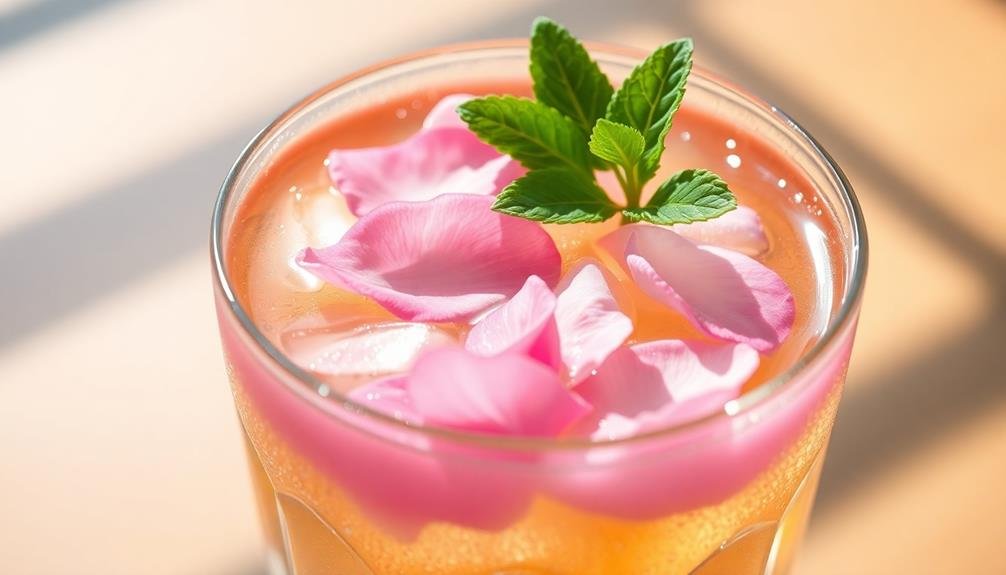
Three words perfectly capture the essence of rose petals in cold tea: elegant, fragrant, and soothing. When you're looking to add a touch of sophistication to your cold brew, rose petals are an excellent choice. They'll infuse your tea with a delicate floral aroma and a subtle sweetness that's both invigorating and calming.
To use rose petals in your cold tea, start with organic, food-grade petals to guarantee they're free from pesticides. You'll want to add about a tablespoon of dried petals per cup of cold water. Let the mixture steep in the refrigerator for 4-6 hours or overnight for a stronger flavor.
Rose petals pair wonderfully with green or white teas, enhancing their natural lightness. You can also combine them with other herbs like lavender or chamomile for a more complex flavor profile. Don't forget to strain the petals before serving, and consider garnishing with a fresh rose petal for an extra touch of elegance.
Beyond their taste, rose petals offer potential health benefits, including anti-inflammatory properties and stress reduction. They're a perfect addition to your cold tea repertoire, especially when you're seeking a moment of tranquility.
Sweet Licorice Root
You'll find sweet licorice root an excellent addition to your cold tea blend, offering a natural sweetness boost without the need for added sugar.
Its soothing properties can help calm a scratchy throat, making it particularly beneficial during cold and flu season.
Beyond flavor and comfort, licorice root also aids digestion, potentially easing stomach discomfort and promoting overall gut health.
Natural Sweetness Boost
Sweet licorice root offers a natural sweetness boost to your cold tea without adding sugar or artificial sweeteners. This herb's unique flavor profile can transform your beverage into a delightful, guilt-free treat.
You'll find that licorice root's sweetness is more complex than regular sugar, with subtle notes that complement various tea blends.
When incorporating sweet licorice root into your cold tea, you'll want to experiment with different quantities to achieve your desired level of sweetness. Start with a small amount and gradually increase it to suit your taste preferences. You can steep licorice root along with your tea leaves or add it separately as a flavor enhancer.
Here are five ways to enjoy sweet licorice root in your cold tea:
- Blend it with mint tea for a invigorating, sweet-cool combination
- Pair it with chamomile for a soothing, naturally sweet bedtime drink
- Mix it with green tea to balance out any bitterness
- Combine it with fruity herbal teas for a complex, sweet flavor profile
- Use it to enhance the natural sweetness of rooibos tea
Remember that licorice root can have some health effects, so consult with a healthcare professional if you have any concerns about consuming it regularly.
Soothing Throat Properties
Renowned for its soothing properties, sweet licorice root offers relief for sore throats and irritation. When added to your cold tea, it can provide a comforting and healing experience, especially during bouts of cold or flu. Licorice root contains glycyrrhizin, a compound that helps reduce inflammation and ease throat discomfort.
You'll find that licorice root imparts a naturally sweet flavor to your tea, eliminating the need for additional sweeteners. It's also known to boost your immune system, making it an excellent choice for cold tea when you're feeling under the weather.
To use licorice root in your tea, simply add a small piece or a teaspoon of dried root to your brew.
Be mindful that while licorice root is generally safe, excessive consumption can lead to side effects. It's best to limit your intake to no more than 1-2 cups of licorice-infused tea per day.
If you have high blood pressure, heart or kidney problems, or are pregnant, consult your doctor before incorporating licorice root into your diet. By using licorice root judiciously, you can enjoy its soothing benefits and enhance your cold tea experience.
Digestive Aid Benefits
Many people find sweet licorice root to be an excellent digestive aid when added to cold tea. This herb's natural compounds can soothe your stomach and promote healthy digestion. When you're experiencing indigestion, bloating, or an upset stomach, a cold tea infused with licorice root might offer relief.
Licorice root contains glycyrrhizin, a compound that can help reduce inflammation in your digestive tract. It may also stimulate the production of protective mucus in your stomach lining, potentially easing discomfort from acid reflux or ulcers. Additionally, this herb can act as a mild laxative, helping to alleviate constipation.
To fully enjoy the digestive benefits of licorice root in your cold tea:
- Steep 1-2 teaspoons of dried licorice root in hot water for 5-10 minutes
- Allow the tea to cool completely before drinking
- Add a slice of lemon or a touch of honey for flavor
- Drink it after meals to aid digestion
- Limit consumption to 1-2 cups per day, as excessive intake may cause side effects
Remember to consult your healthcare provider before regularly consuming licorice root, especially if you have high blood pressure or are pregnant.
Frequently Asked Questions
Can I Mix Different Herbs in My Cold Tea?
You can mix various herbs in your cold tea. It's a great way to experiment with flavors and create unique blends. Try combining mint with lemon balm, or hibiscus with chamomile. Don't be afraid to get creative!
How Long Should I Steep Herbs for Cold Tea?
You'll want to steep herbs for cold tea longer than hot tea. Aim for 8-12 hours in the refrigerator. If you're in a hurry, steep for 30-60 minutes at room temperature, then add ice.
Are There Any Herbs to Avoid in Cold Tea?
You should avoid using herbs like comfrey, ephedra, and kava in cold tea, as they can be harmful when consumed in large quantities. It's best to stick with safe, common herbs like mint, chamomile, or ginger for your cold brews.
What's the Best Way to Sweeten Herbal Cold Tea?
You can sweeten your herbal cold tea with honey, stevia, or agave syrup. If you're feeling adventurous, try fruit-infused simple syrups. For a healthier option, use fresh fruit slices or a splash of 100% fruit juice.
Can I Use Dried Herbs Instead of Fresh Ones?
Yes, you can use dried herbs instead of fresh ones. They're more concentrated, so you'll need less. Start with about 1/3 the amount of fresh herbs called for. Adjust to taste, as dried herbs can be more potent.
In Summary
You've now discovered nine incredible herbs to transform your cold tea experience. Don't stop here! Experiment with different combinations to find your perfect blend. Whether you're looking for a revitalizing kick or a soothing sip, these herbs will elevate your tea game. Remember to adjust steeping times and ratios to suit your taste. With these flavorful additions, you'll never settle for a boring iced tea again. Enjoy your herb-infused cold tea adventures!

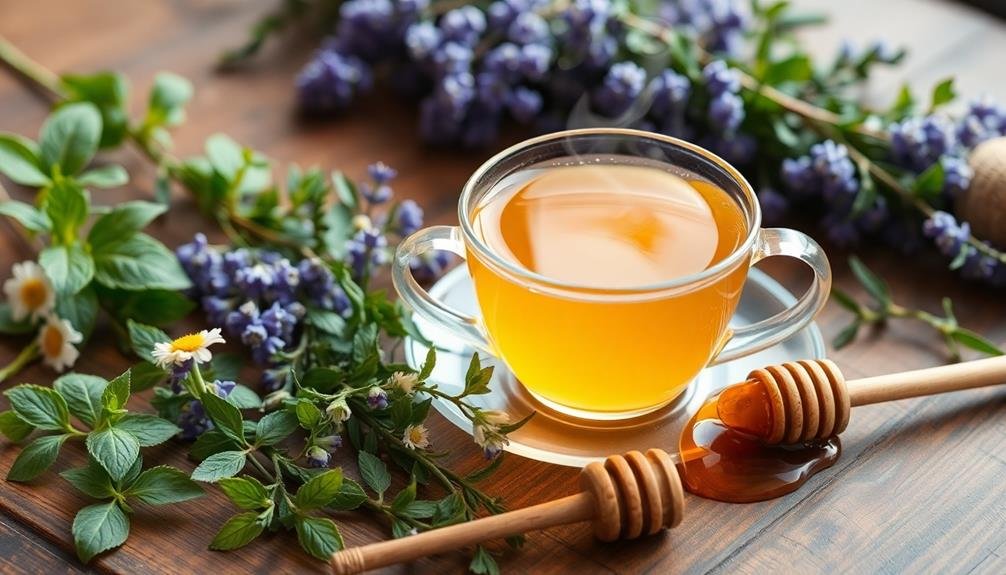



Leave a Reply